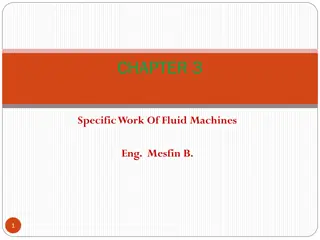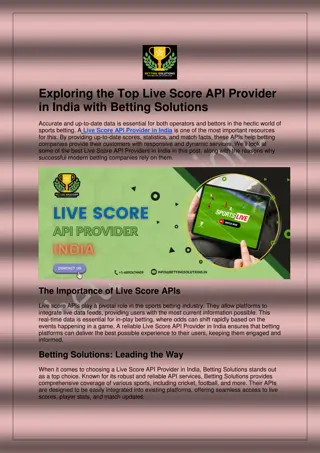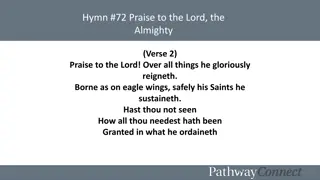
Visualizing Population Trends and Agricultural Outputs Over Time - Line Graph Examples
Explore different types of line graphs to understand population growth in City E from 1970 to 2015, as well as agricultural outputs in City F from 2014 to 2018. Learn to create multiple line graphs and a combined line and bar graph to represent data efficiently.
Download Presentation

Please find below an Image/Link to download the presentation.
The content on the website is provided AS IS for your information and personal use only. It may not be sold, licensed, or shared on other websites without obtaining consent from the author. If you encounter any issues during the download, it is possible that the publisher has removed the file from their server.
You are allowed to download the files provided on this website for personal or commercial use, subject to the condition that they are used lawfully. All files are the property of their respective owners.
The content on the website is provided AS IS for your information and personal use only. It may not be sold, licensed, or shared on other websites without obtaining consent from the author.
E N D
Presentation Transcript
3. Line graph Line graphs are commonly used to display the variation of an item over time or with distance To show the data trend Drawing steps: Population of City E from 1970 to 2015 Year 1970 1975 1980 1985 1990 Population (thousand) 4,000 4,500 5,100 5,500 5,800 Year 1995 2000 2005 2010 2015 Population (thousand) 6,300 6,700 6,800 7,100 7,300
3. Line graph Draw the X-axis, and then label the years. Draw the Y-axis, and then label the unit Population (thousand) and values.
3. Line graph Take the year of 1970 as an example. Mark a symbol at 4,000 on the Y-axis to represent the population in 1970. Repeat Step 3. Mark the population from 1975 to 2015.
3. Line graph Connect all the marks with straight lines. Add a title.
3. Line graph A. Multiple line graph It displays the variation of multiple items over time or with distance Agricultural outputs of City F from 2014 to 2018 (in kg) Year 2014 2015 2016 2017 2018 Food crops 1,000 910 850 760 750 Fruit 550 700 730 840 990 Vegetables 600 620 700 790 880
3. Line graph A. Multiple line graph
3. Line graph B. Combined line and bar graph It uses both bars and curves to display different variables, e.g. climatic graph and hydrograph Drawing steps: Climate data of Place G Month Jan Feb Mar Apr May Jun Mean temperature (oC) 16 17 19 23 26 28 Precipitation (mm) 25 54 82 175 305 456 Month Jul Aug Sep Oct Nov Dec Mean temperature (oC) 29 29 28 26 22 18 Precipitation (mm) 377 432 328 101 38 27
3. Line graph B. Combined line and bar graph Draw two Y-axes. Label the unit Temperature (oC) and values on the left Y-axis. Then, label the unit Precipitation (mm) and values on the right Y-axis.
3. Line graph B. Combined line and bar graph Draw the X-axis. Divide it into 12 equal parts and label the months.
3. Line graph B. Combined line and bar graph At the middle point of each month, mark the mean monthly temperature. Then, connect the points with a curve.
3. Line graph B. Combined line and bar graph Use bars to show the precipitation of different months. Add a title.
3. Line graph C. Cumulative frequency curve It shows the degree of concentration of a variable in the population, e.g. Lorenz curve Drawing steps: Education levels of City H's citizens in 2018 Number of citizens (thousand) Grade Education level 1 Kindergarten or below 3,250 2 Primary 3,620 3 Junior secondary 1,050 4 Senior secondary 1,790 5 Tertiary (Diploma and bachelor degree) 1,160 6 Tertiary (Postgraduate degree) 420 Total 11,290
3. Line graph C. Cumulative frequency curve Draw the X-axis, and then label the unit Grade of education level and values. Draw the Y-axis, and then label the unit Cumulative percentage of citizens (%) and values.
3. Line graph C. Cumulative frequency curve Convert the number of citizens with different education levels into percentages. Take Kindergarten or below as an example: (3,250 11,290) 100% = 29% Education levels of City H's citizens in 2018 Number of citizens (thousand) Grade Education level Percentage 1 Kindergarten or below 3,250 29% 2 Primary 3,620 32% 3 Junior secondary 1,050 9% 4 Senior secondary 1,790 16% Tertiary (Diploma and bachelor degree) 5 1,160 10% 6 Tertiary (Postgraduate degree) 420 4% Total 11,290 100%
3. Line graph C. Cumulative frequency curve Convert the percentages into cumulative percentages. Take Kindergarten or below and Primary as an example: 29% + 32% = 61% Education levels of City H's citizens in 2018 Number of citizens (thousand) Cumulative percentage Grade Education level Percentage 1 Kindergarten or below 3,250 29% 29% 2 Primary 3,620 32% 61% 3 Junior secondary 1,050 9% 70% 4 Senior secondary 1,790 16% 86% Tertiary (Diploma and bachelor degree) 5 1,160 10% 96% 6 420 4% 100% Tertiary (Postgraduate degree) Total 11,290 100%
3. Line graph C. Cumulative frequency curve For grade 1 of education level, mark a symbol at 29% on the Y-axis to represent the cumulative percentage of citizens with education level of kindergarten or below. Repeat Step 5. Mark the cumulative percentages on the graph paper, and connect the points with a curve to form a Lorenz curve.
3. Line graph C. Cumulative frequency curve Draw a diagonal line (45oline) on the graph as the line of equality. Add a title.






















